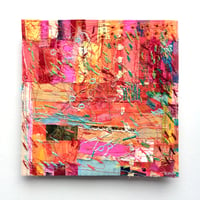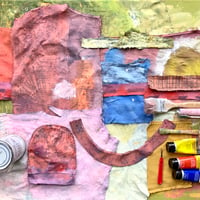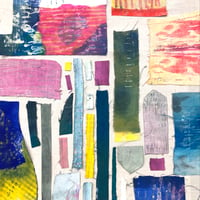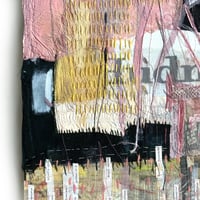25% discount applied automatically at checkout!
Ten re-recorded lessons ready for you to enjoy at your own pace. Once you purchase the course, you will need to wait for the access email to be sent manually to you. Depending on the time of day and your time zone, there may be a few hours between purchase and email. Please type your email address carefully and check your junk folder.
Originally released: 2024. Continued access period: LIFETIME
SYLLABUS: this inventive course is all about exploring different ways to use old clothing and unwanted fabric in textile art. The approach is, of course, driven by sustainability, but also by the conceptual and motivational benefits of chance and happenstance. In the course of ten lessons we will paint, collage, and stitch experimentally, starting with the creation of a book for storing and documenting exploratory swatches as the course progresses. The principle of thrift (to use resources carefully and without waste), when applied to art, requires open mindedness and innovation. It is liberating to accept that you simply cannot have the expectation of a particular outcome when you don’t know how materials will behave. Fabric offcuts and worn garments have inconsistent weights, weaves, and patterns of wear. They receive paint and other media in different ways, resulting in unpredictable changes in colour, texture, and malleability. These, in turn, inspire serendipitous concepts, compositions, and methods of construction. The result is a collaboration between artist and material. The flexibility of this course will enable students to adapt the method to the contents of any drawer of scraps or thrift store haul. It is filled with tips and insights from an artist who has been using this approach for three decades, since making textile models at architecture school using household emulsion and the contents of her patch bag.
FORMAT: a new session (ten in total) was uploaded to a course page on my website every weekday during the live run of this course. Each daily session includes a learning objective, topic overview, contextual description, and video tutorial. In addition, two short bonus films, with briefs for weekend activities, were shared on the two Friday afternoons during the run. Content will remain accessible for the "lifetime" of the course. When I eventually observe that the course is no longer being accessed by students, I will email and give you four months notice of its retirement.
MATERIALS:
• A couple of old garments or unwanted items of household linen (such as a tea towel or pillowcase). Natural fibres (cotton, linen, silk, bamboo etc), or blends containing them, and non-stretchy weaves are preferable. If they are stained, torn, or scorched, that’s all the more interesting. Plain, striped, and patterned are all fine, though at least one plain would be great.
• A collection of fabric scraps, the more varied (in texture, colour, weight, opacity, weave and so on) the better. Again, natural fibres are preferable, though not essential. A mixture of both plain and patterned surfaces would be good. All shapes and sizes are fine (nothing is too small). If you don’t already have a suitable stash, they can be bought cheaply online (Google “buy fabric scraps”) or in a craft/sewing shop. You might even call a local dressmaker or repair service and ask if you can relieve them of their offcuts…they would probably be pleased to have materials diverted from the bin.
• Any other textile items you want to experiment with. Here are some ideas: fabric packaging from food or toiletries (I’ve had risotto rice in beautiful printed sacks before, and been given soap in pretty organza pouches), old cotton handkerchiefs (there must be tonnes of these lying around doing nothing these days), soft toys, dolls outfits, vintage coasters, doilies or antimacassars, tote bags (the sort with screen printed logos are fun) and so the list could go on.
• Thread (you’ll need regular gauge, for hand and machine sewing, and stranded for embroidery) in a selection of light, dark, muted, and bright colours. A minimum of six would be good.
• Needles (for both hand and machine sewing, and embroidery)
• Sewing machine. A basic one will be fine, preferably (though it’s not essential) one that allows you to lower the feed teeth, or fit a plate on top of them, to enable free-motion stitching.
• Fusible webbing. This is double-sided heat-activated adhesive that comes by the metre (or yard) on a paper support. In the UK it's called Bondaweb or Heat'n'Bond. In the USA it's Wonder Under. Email me if you can't find it where you are, and I'll try to help. A couple of pieces, each approx 50cm (20") square will be enough for starters.
• Seam ripper (aka "quick unpick").
• Cutting mat and craft knife or rotary cutter.
• Medium-sized sewing hoop (20cm (8”), or so, diameter)
• Artists acrylic paint
• Iron and ironing board
• Fabric scissors
CONCESSIONS
The lower price is provided on an honesty box basis for people on a genuinely low income. It is funded via a private grant for widening participation in art education. The discount is not funded by customers paying the full price. Please access it only if you are in actual need.
COPYRIGHT
All content is copyright Tansy Hargan. By signing up for this course you agree not to share, distribute or monetise its content in any way. Videos are not to be replayed in classrooms and studios. If you are a teacher and would like to see me (in person or online) in your school or studio please get in touch [email protected]




















